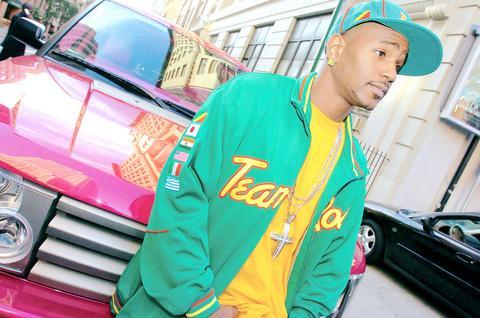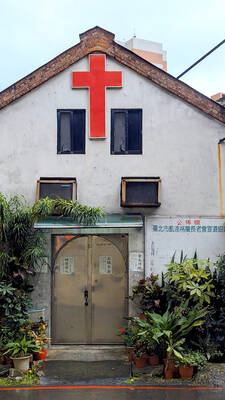In a gated condominium community in Fort Lee, New Jersey, the dense shrubbery suggests a botanical garden more than a residential one. A lantern at the foot of each house's staircase is illuminated before sundown, and there is a late-model sport utility vehicle in nearly every drive. But there is only one hot-pink Range Rover. That is how you can tell the house of Cameron Giles.
For the better part of two years, pink has been the dominant color in the life of Giles, a rapper who performs as Cam'ron. "When I did pink, I did it so I wouldn't be dressing like everybody else," he said. The color seemed guaranteed to set him apart in the world of hip-hop, where men's style tends to conform to notions of hypermasculinity.

PHOTO: NY TIMES
When Giles first wore pink, in the summer of 2002 in a video for Hey Ma and at music industry events, he thought he had found a one-of-a-kind look.
A funny thing happened, though. Not long after Hey Ma began climbing the Top-40 charts, pink began to show up in the wardrobes of other urban young men. At last year's Puerto Rican Day Parade, pink clothing on men offered a counterpoint to the event's macho posturing.
Other hip-hop figures like P. Diddy and Russell Simmons, and the R & B singer R. Kelly, wore pink.
"Cam was the first hard-core rapper to rock pink," said Emil Wilbekin, a former editor in chief of Vibe magazine, who is now an executive at the fashion house Marc Ecko. "What was interesting was how quickly the streets caught on."
Giles himself, however, said he is over the look. He wants to move on. "Me, personally, I haven't worn pink in about four or five months, just for the simple fact that everybody's wearing pink," he said the other day.
He plans to adopt a new color, raising the possibility that he might start a new fad. The sartorial decisions of hip-hop stars strongly affect clothing trends. The fortunes of companies like Tommy Hilfiger and Timberland rose after they were embraced by rap stars, and labels like Sean John and Ecko stake everything on anticipating the urban market.
Giles is cagey about his next big color, hoping to find a way to reap financial gains this time. That might include starting a clothing line of his own. "I'm not going to tell anybody until I patent it," he said of his post-pink color.
"If this many people enjoy my style, and other people want to be fly in the same type of fashion I'm being fly in, then I might as well benefit off it."
It is possible, though, to make an educated guess about Giles's secret. His next album, due in December, is called Purple Haze. A limited-edition cap he designed last summer for the New Era Cap Company featured metallic purple accents. One of his rap crews is called Purple City, a nod to a neighborhood in Harlem and a type of marijuana sold there.
And in April, Giles, in partnership with a company called Harbrew Imports, introduced Sizzurp, a "purple punch liqueur" named for a codeine-laced concoction popular in the South.
Giles, 28, was born and raised in Harlem, and he found fashion at an early age. "Just growing up in Harlem, it didn't matter what you had to do to get fresh, you would do it," he said. "I recall the Skate Key in the Bronx," he continued, referring to a roller disco popular in the 1980s. "You maybe had to go steal your mom's earrings and go pawn them, borrow US$10 from four or five people, but when you got there, it looked like you had $8,000 in your pocket."
In the mid-1990s, he joined his first rap crew, Children of the Corn. Membership required clothes as impressive as one's rhymes -- Sergio Tacchini track suits in particular. "I had to make sure I was on point" around the other rappers, Giles recalled. "They used to go all the way downtown to look for stuff nobody would have. Growing up with them was a privilege."
Giles found stardom as a soloist in 1998 when his album Confessions of Fire went gold. A follow-up, Come Home With Me, in 2002, went platinum and reached No. 2 on the Billboard charts.
Although he has not had the mainstream popularity of P. Diddy or Jay-Z, he is Harlem's most prominent rapper, famous for a sort of avant-garde gangster rap that is dense with polysyllabic rhyme schemes and fashion references.
Giles credits his stylist, Monica Morrow, with introducing him to pink. "I came up with it," Morrow said, "but him putting it on made everyone fall in love with it."

The Directorate-General of Budget, Accounting and Statistics (DGBAS) told legislators last week that because the Chinese Nationalist Party (KMT) and Taiwan People’s Party (TPP) are continuing to block next year’s budget from passing, the nation could lose 1.5 percent of its GDP growth next year. According to the DGBAS report, officials presented to the legislature, the 2026 budget proposal includes NT$299.2 billion in funding for new projects and funding increases for various government functions. This funding only becomes available when the legislature approves it. The DGBAS estimates that every NT$10 billion in government money not spent shaves 0.05 percent off

Dec. 29 to Jan. 4 Like the Taoist Baode Temple (保德宮) featured in last week’s column, there’s little at first glance to suggest that Taipei’s Independence Presbyterian Church in Xinbeitou (自立長老會新北投教會) has Indigenous roots. One hint is a small sign on the facade reading “Ketagalan Presbyterian Mission Association” — Ketagalan being an collective term for the Pingpu (plains Indigenous) groups who once inhabited much of northern Taiwan. Inside, a display on the back wall introduces the congregation’s founder Pan Shui-tu (潘水土), a member of the Pingpu settlement of Kipatauw, and provides information about the Ketagalan and their early involvement with Christianity. Most

The People’s Republic of China (PRC) was out in force in the Taiwan Strait this week, threatening Taiwan with live-fire exercises, aircraft incursions and tedious claims to ownership. The reaction to the PRC’s blockade and decapitation strike exercises offer numerous lessons, if only we are willing to be taught. Reading the commentary on PRC behavior is like reading Bible interpretation across a range of Christian denominations: the text is recast to mean what the interpreter wants it to mean. Many PRC believers contended that the drills, obviously scheduled in advance, were aimed at the recent arms offer to Taiwan by the

Like many retirement communities, The Terraces serves as a tranquil refuge for a nucleus of older people who no longer can travel to faraway places or engage in bold adventures. But they can still be thrust back to their days of wanderlust and thrill-seeking whenever caretakers at the community in Los Gatos, California, schedule a date for residents — many of whom are in their 80s and 90s — to take turns donning virtual reality headsets. Within a matter of minutes, the headsets can transport them to Europe, immerse them in the ocean depths or send them soaring on breathtaking hang-gliding expeditions